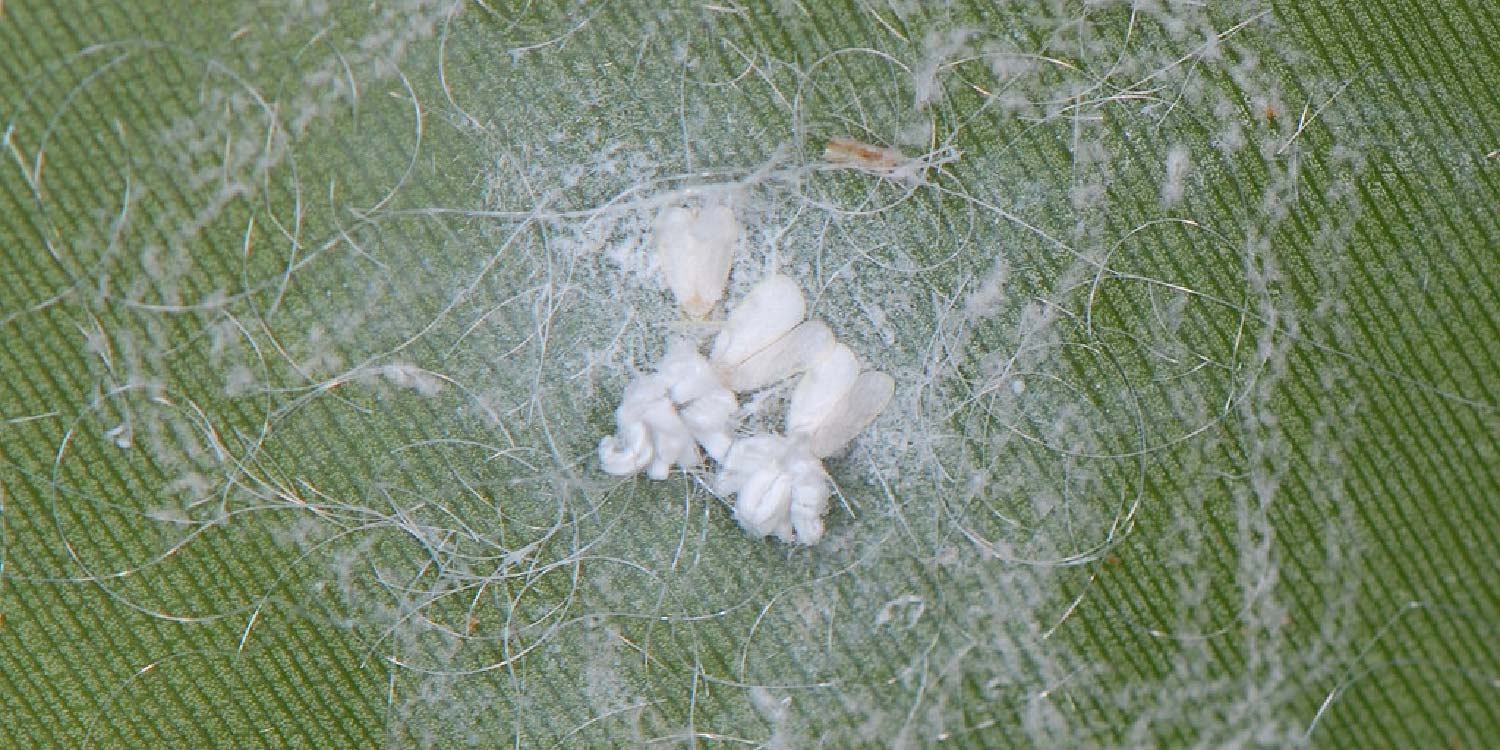The spiraling whitefly (Aleurodicus dispersus) belongs to the family Aleyrodidae and is believed to have originated in the wet tropics of Central and South America.
Aleurodicus dispersus is polyphagous, i.e., it is not reliant on a single host but can feed on many different species of plant.
It is a major agricultural pest especially in mango farming.
DESCRIPTION
Eggs
These are tiny, elliptical, smooth surfaced, yellow to tan, with numerous tiny waxy secretions. They are deposited on the underside surface of a leaf, in irregular, waxy lines, typically forming a somewhat spiraling pattern. The spiraling of waxy material is the feature from which this whitefly derives its common name.
Larvae
There are four immature stages, the first three are referred to as larvae and are continuous feeders. The first larval stage, commonly known as a “crawler”, is the only immature stage with functional legs and distinct antennae. Subsequently, the first stage is the only stage capable of active movement. All other immature stages are sedentary.
When settled, the crawlers develop a characteristic row of mid-back waxy tufts on the anterior of their body. The waxy tufts continue to grow as more material is secreted. During the third larval stage glass-like rods of wax appear along the sides of the body. These glass-like rods are extruded through special pores on the insect’s body and may be as much as 8 mm long, although most are shorter because of fragmentation.
Pupae
The final and fourth immature stage is considered the pupa of this species. This stage feeds during the earlier phases then stops feeding and undergoes internal tissue reorganization before molting into the adult. This stage serves as the basis for most of the taxonomic characterizations and must be observed under the microscope for those characteristics.
The mature pupae bears a copious amount of a white cottony secretion extending upward and outward from the back. Some of the secretion is fluffy and some waxy and in ribbons as long as, or longer than, the width of body.
Pupae are colorless or yellowish, nearly oval, flat and approximately 1 mm long and 0.75 mm wide.
Adults
They are similar in appearance to those of many other species of whiteflies. They are white and quite small 2-3 mm in length and coated with a fine dust-like waxy secretion. They somehow resemble tiny moths, and both sexes are winged. The eyes of this whitefly are dark reddish-brown and wings are transparent after emergence from the pupal casing, but develop a white powder covering after a few hours. The forewings each have two characteristic black spots.
LIFE CYCLE
The female deposit eggs on the underside surface of the leaf and each egg hatches into a tiny active crawler, roughly the same size as the egg. The crawler moves out over the foliage of the host plant and then transforms into an inert, sedentary nymphs stage that attaches to the underside of the leaves where it sucks nutrients from the leaves.
The nymphal stage has no visible legs and grows progressively through a series of instars, each producing more wax and sugar secretions. The final instar acts as pupa, out of which the adult whitefly emerges.
The time from egg to adult can be less than three weeks in warmer conditions and longer in cooler conditions. The female whitefly, which is identical to the male can lay large numbers of eggs depending on prevailing temperature condition.
Females begin laying eggs within a day of emergence and continue to lay eggs throughout her lifetime. Unmated females produce only male progeny while mated females produce both sexes.
Only the adult stage disperses beyond the leaf on which the egg is laid
DAMAGE
Mango spiraling whiteflies are generally active during calm, still times of the day e.g. at dawn and dusk and cause direct feeding damage and indirect damage.
Direct damage is caused by the piercing and sucking of sap from foliage by immature and adult stages of whiteflies. The majority of feeding damage is done by the first three nymphal stages. This feeding majorly causes premature dropping of leaves.
Indirect damage is due to the accumulation of honeydew and white, waxy flocculent material produced by the whiteflies. This sweet and watery excrement is fed on by bees, wasps, ants and other insects.
The honeydew also serves as a substrate on which sooty mold grows. Sooty mold blackens the leaf, decreases photosynthesis activity, decreases vigor and often causes disfigurement of the plant and lessens the market value of the fruits or makes them unmarketable. The flocculent material produced by the nymphs is scattered by the wind and creates an unsightly nuisance
MANAGEMENT
Chemical method
Use of chemicals has been the most effective way in management of this pest.
Insecticides with both contact and systemic properties are recommended and these include the following;
- TAURUS 500SP 10g/20l
- PROFILE 440EC 30ml/20l
- PRESENTO 200SP 5g/20l
- EPITOME ELITE 500SP 10g/20l
- LEXUS 247SC 8ml/20l
- EMERALD GOLD 700WDG 5g/20l
- AMAZING TOP 100WDG 5g/20l
- EMERALD 200SL 10ml/20l
- LOYALTY 700WDG 5g/20l
- DEFENDER 25EW 40ml/20l
Non-chemical control methods
- Plant resistant varieties
- Use of sticky traps
- Maintain field hygiene/sanitation
- Ensure proper weed control
- Practise crop rotations with non-host plants
- Prune excess branches to give the plant an “umbrella” appearance with scattered openings in the canopy to allow sun, wind, and rain to penetrate. This reduces the surface area of foliage that needs to be sprayed and eliminate shelter for the spiraling whitefly.
- Ensure a proper nutrition to improve plant vigor. Healthy plants able to withstand spiraling whitefly infestations.
Note;
- Mixing the insecticide with INTEGRA 3ml/20l helps improve the efficacy of the insecticide. It is a sticker, spreader, penetrant and wetter.
- To prevent the pest from developing resistance over any of the insecticides, it is highly recommended that several insecticides be alternated within a crop’s season, instead of using a single chemical.
- To clean the sooty mold, JAMBO CLEAN 100ml/20l is sprayed to the crop.
- Timely management of the pest is very crucial.






